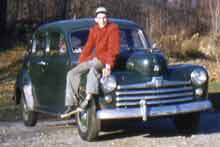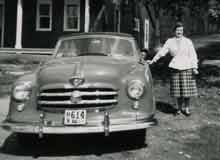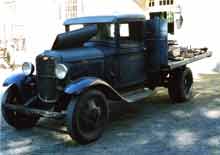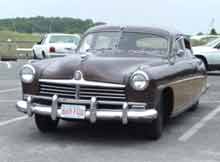A Spare on the Side
Wayne Graefen has found this nifty little custom in Junction, Texas, one of the hamlets in Greater Wayne's World, which comprises much of the central part of the Lone Star State. Built probably in the 1950s, it's based on a 1941 Ford coupe body and sports a '53 Studebaker windshield and 1935 Ford wire wheels. The lines and the workmanship are both pretty nice, better than found on many customized automobiles. The instrument panel reprises the front end theme, a nice touch. Original power came from a 354 cid Chrysler hemi, through original Ford trans to Columbia overdrive. The car now has a 428 cid Ford engine and 9-inch rear.
Wayne's only quibble is with the vestigial sidemount bulges, which he says are "too far back in the fenders to possibly hold tires - if they are going to be there they should be functional." I agree, and would add that the refrigerator-like door hinges look tacky, too.
Sidemounted spares are an American institution. Conceived as a simple and functional way to carry a spare tire, sitting on the running board and lashed to the body, as time went on they nestled into the front fender and became more streamlined, finally fully-enclosed in metal covers. The last General Motors cars with sidemounts were the 1940 Buicks and Cadillacs, by which time the tires were mostly styling devices. Packard, getting full use of the old-style bodies on their senior series, used them until 1942.
This little Ford custom is not the last American car to use sidemounts, though. Racing driver John Fitch, who after retirement from the track built modified "Sprint" versions of the Corvair with handling enhancements and four-carb engines, envisioned a more sophisticated car. The Phoenix, also Corvair-based but with special body penned by Coby Whitmore and built in Italy by Frank Reisner's Costruzione Automobili Intermeccanica, featured real sidemounts, gentle blisters on the front fenders but with real tires under removable covers. The concept was intended to house different size spares, as the Phoenix was to have narrower tires on the front than on the rear. In the end, it didn't, and production never started because Federal motor vehicle standards inconveniently intervened.
The Phoenix was built in 1966, and I believe it to be the last American car with sidemounts. If you can think of a later example, please contact the CarPort.





